There Goes the Neighborhood
I live out in the woods and my closest neighbors are trees, so if the title is taken literally, it can mean only one thing:
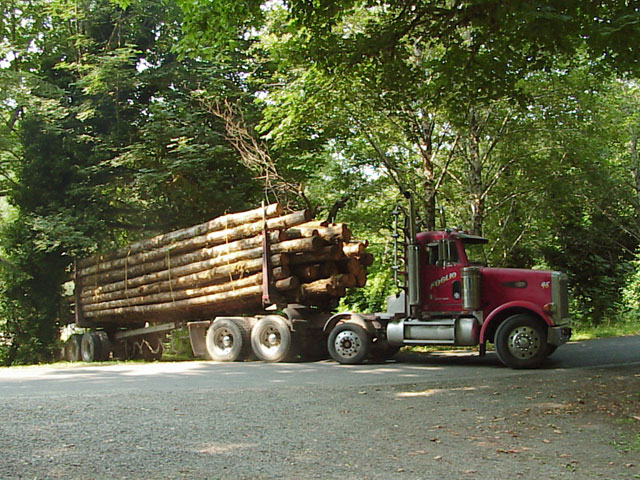
Put the forest on wheels and drive it away.
This is a project that has been in the making for some time. I've been granted some funds by the government to do some conservation repairs on the creek here, repairing some erosion and removing and reconstructing some of the previous owner's bad attempts to do the same themselves. These grants take the form of "matches", that is, I have to provide a percentage of the project cost either in funds, or in "in kind" contribution. In this particular case, my match is to take out a small stand of decadent alder trees from alongside the stream and plant conifer species, cedar, hemlock, and fir in their place. This provides better shade for the creek and encourages salmon breeding.
Last week, my part of the project started with a logger that I hired, Richard, bringing out an excavator and a small caterpillar tractor. The excavator was used to widen a narrow, grassy path back to the trees to accommodate the equipment necessary to complete the job.
Friday, the trees started falling. They didn't really make much noise, just a muffled "whump" when they hit the ground. After a small pile was down, Shannon, Richard's assistant, came over with the cat, looped choker cables around the tree butts, and hauled them across a small draw to be cut to length.
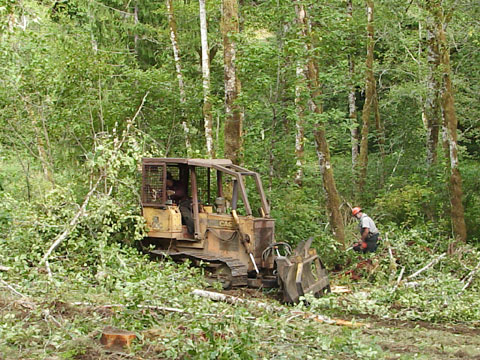
When the pile of trimmed logs got large enough that the small area we were using as a landing got too full, Richard would come over with the excavator and pile the logs up to one side, creating a "deck" of logs.
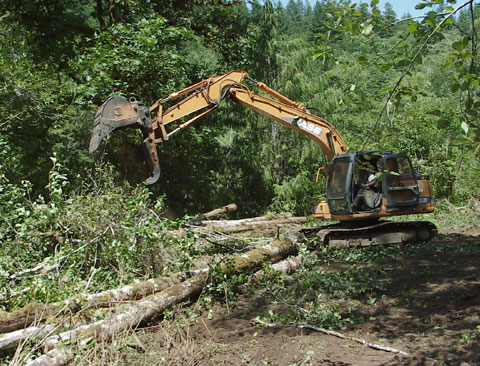
Some of the trees leaned the wrong way (how rude of them to grow incorrectly). The easy way to fall them where they needed to be was to lean on them with the excavator bucket and toss them aside as they were cut. In one instance, Richard had Shannon back the cat up to a tree, cable onto it with a choker and give a bit of tension. I don't know what was supposed to happen, but as the tree was cut and began to fall, it dropped directly onto the tractor, impacting and coming to rest on the heavy steel cage, with Shannon sitting inside.
After two days of falling, yarding, bucking, and decking, about 90 trees were down and ready to go to the mill.
This morning, Richard brought two log trucks to the property, one a "long loader" belonging to the local trucking company, and the other, a "self loader", which has a hydraulically-operated articulated arm mounted behind the cab to move and stack logs. Richard used the self loader to partially load his truck with logs, then began loading the hired truck.
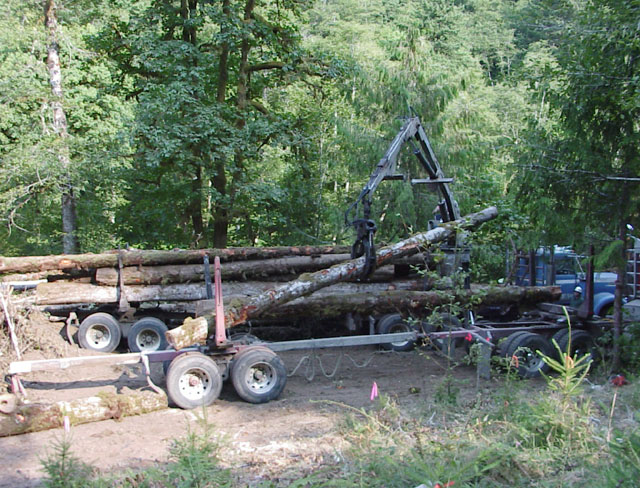
This is when I learned that these truck are equipped with built-in weight scales. The bunks (the vertical arms that cradle the logs) are mounted to the truck frame with electronic load cells, and a display in the cab indicated the net weight on the truck and trailer, and also integrates the tare weight of the truck for a gross total. Fines levied by the Weighmaster are hefty, and finding out that a truck is too heavily loaded when it rolls through one of the frequent weigh stations is an expensive risk. The good news for me is that they were able to load the truck to within a few hundred pounds of it's limit, meaning that I'll be getting the best value possible for the hauling. A full truckload of these alder logs is worth $1,500-1,675. Hauling to the mill is expensive, $450-500 per load, so having the truck as full as possible is the best value.
Unfortunately, I have only two loads to send in to the mill, and the value of the timber isn't going to come close to covering the cost of this operation. We had hoped for three truck loads, but we've pretty much cleaned out the alder from this side of the creek. I just have to look at the expense as part of my match for the grants.
Half a dozen or so of the logs were stamped on the ends using an axe with a brand embossed into it. This particular log is what is known as a "rifle barrel", the hole in the center extends at least four feet up the trunk.
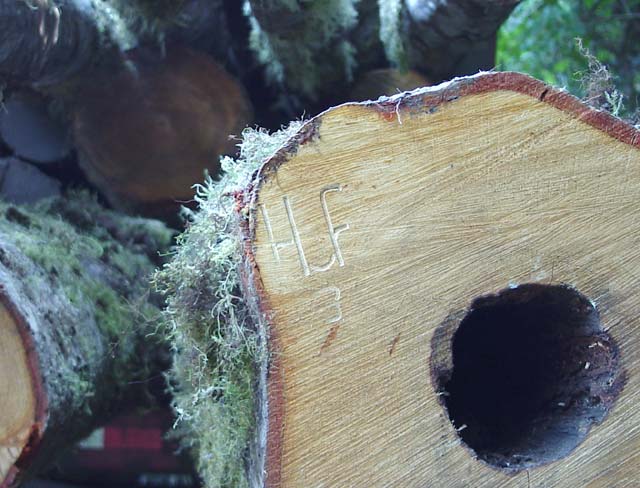
This is to identify the load to prevent mix-ups and discourage theft. The brand is unique to Richard's company, and can be traced back to him. Logs cut and transported from public lands under government contracts must all be branded at both ends. Private log sales need only a few logs in each load branded.
Once concern I did have was how well the bridge over the creek was going to stand up to all the weight of a truck full of logs crossing. Last month, I was notified by the local fire department that unless I could provide certified documents stating the weight capacity of the bridge, they would not drive over it with their equipment to fight fires or even cross it with an ambulance. Fortunately, this bridge was thoroughly investigated by a professional engineer in 1997, at which time overly strong steel reenforcing beams were installed. These steel structural components, along with the four pressure treated wooden beams are certified for 46,000 pounds of weight. This satisfied the fire Marshall's inquiry.
I kind of thought 23 tons was a bit light, considering the apparent strength of the supporting members. The truck driving over the bridge this morning allayed any fears I might have had about the weight carrying ability of the bridge. The tractor of this truck had to weigh in at 50,000 pounds, and the bridge didn't budge, didn't even deflect downwards in any apparent way.
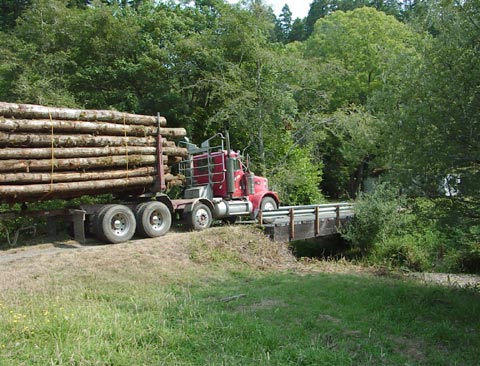
So now I have a 1¼ acre clear cut.
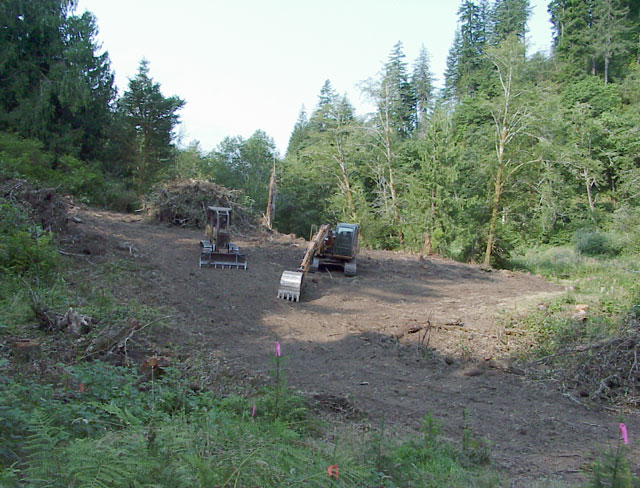
There are three huge piles of slash, consisting of the branches and leaves of the trees, the understory, which was salmonberry, elderberry, blackberries, and various weedy species. These will be burned this fall when fire season opens. There is about a log truck load's worth of firewood, the spindly tops of the trees, diseased, stained, or otherwise non-marketable logs and log pieces, etc. I'll have enough firewood to last ten years.
Starting in December, this area will be planted with 400+ tree seedlings, provided by the conservation service. Part of my match is to keep the area free of tall understory growth for a period of six years so that the new trees have a chance to establish and get tall enough to stand above any shade that the understory causes.
This photo was taken while I was standing in a small patch of planted trees, firs that were put in two years ago. There are more hemlocks to the immediate left, hemlocks and cedars to the right, and a planting of two-year-old firs on the other side of the big slash pile. Richard and Shannon did a great job working around these small trees and protecting them while felling one-ton logs and clanking around on their machines.
I think what will please me most is when the grass grows back in on the paths and new road, and the stumps disappear in new spring growth. Only then will the scars of this operation begin to heal.
Original material ©1996-2026 Mr. Sharkey | All rights reserved
